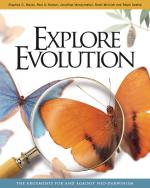In 2007, a new “intelligent design” book entitled Explore Evolution (“EE”) appeared on the market.
Explore Evolution is explicitly marketed to public school teachers. For example, at a 2008 Biola University symposium for science teachers a pitch was made for adopting Explore Evolution. The quote below comes from the symposium's website:
A US Supreme Court decision allows teachers to teach biology in a way that incorporates “a variety of scientific theories…with the clear secular intent of enhancing the effectiveness of science instruction.” The new supplemental textbook Explore Evolution, when coordinated with other materials, empowers teachers and students to better fulfill these public educational goals.
Biola Science Teacher Symposium 2008 (accessed August 8, 2008.)
But students who read Explore Evolution will come away with a flat-out wrong understanding of evolution.

This book uses the creationist “evidence against evolution” and “teach the controversy” strategies to misrepresent scientific consensus and distort the conclusions of legitimate scientific research. Explore Evolution offers anonymous “critics” in place of substantive analysis.
Explore Evolution promotes “intelligent design” creationism. Four of the book’s five co-authors are closely tied to the “intelligent design” creationism movement. Lead author Stephen C. Meyer is a Discovery Institute (DI) vice president and program director of the DI’s Center for Science and Culture. Paul A. Nelson is a fellow of the DI. In 2005 in the Kitzmiller trial, Scott Minnich testified in favor of teaching “intelligent design” in public schools.
Beneath all its distortions, all its misrepresentations of modern evolutionary science, Explore Evolution uses familiar and long-refuted creationist anti-evolution arguments. Students who are required to read this book in a science classroom will be confused by its flagrant inaccuracies, and will be put at a disadvantage in standardized tests which require an understanding of modern biology.
NCSE and a team of consulting scientists have prepared this detailed chapter-by-chapter, page-by-page analysis of the book’s errors, failings, and distortions.
Each link below corresponds to a chapter in Explore Evolution. Each chapter expands into a list of specific problems in Explore Evolution.
Scientific controversy vs. social controversy
- "Controversy" over evolution
- Evolution, climate change, plate tectonics, and string theory
- "Key aspects" of evolution
- References
Educational policy and terminology
- "Historical science" vs. "experimental science"
- Evaluating the quality of a scientific explanation
- References
- Meanings of "evolution"
- Evolutionary mechanisms
- Universal Common Descent
- "Fundamentally new" organisms
- References
- Transitional Fossils Are Not Rare
- Do animal forms change or stay the same?
- Darwin on Transitional Fossils
- The Sequence of Transitional Fossils
- Whale Evolution
- The Sizes of Transitional Fossils
- Sudden Appearance?
- The Cambrian Radiation in the Geologic Record
- Creationist Statistics
- Soft-bodied fossils
- Cal Academy of Sciences display
- Do scientists support polyphyletism?
- Evidence for Single Origin of Life
- Nature of Scientific Disagreement
- Malcolm Gordon
Phylogeny & the Nature of the Fossil Record
- Stability of Phyla
- Sudden taxonomic levels
- Fossil Preservation
- Absence of Fossil Evidence
- Punctuated Equilibrium
- Homology and similarity
- Homologous structures, genes, and developmental pathways
- Circular definitions
- Common function vs. common ancestry
- Vertebrate limbs
- Similarity of shape vs. similarity of form
- Convergence vs. natural selection
- Convergence and common descent
- Do Different Genes Mean Different Phylogenetic Trees?
- Phylogenetic Trees and Molecular Family Histories
- The Last Universal Common Ancestor
- Malcolm Gordon
Evolving Codes and Novel Genes
- Darwin on Dissimilarities
- Ontogeny & Phylogeny
- Haeckel's Drawings
- Accuracy in embryo illustrations
- The Earliest Stages
- Sedgwick's Two Challenges
- Michael Richardson's photographs
Fixity of species and common descent
Artificial and Natural Selection
- Biology Texts
- Modern Galapagos Finches
- Peppered Moths
- Kettlewell's Experiments
- Where Peppered Moths Rest
- Mutation Definition
- Protein Coding
- Normal Protein
- Mutation Accumulation
- Compensatory Mutations
- Pre-Existing Resistance
- Protein Changes
- The Four-Winged Fly
- Survival
- "Hopeful Monsters"
- Hox & Development
- Modularity in Hox genes
- Body Plans
- Mutations & New Body Plans
- Developmental Controls
- Bacterial speciation
Claims about complexity of cells
Claims about evolution of flagella
